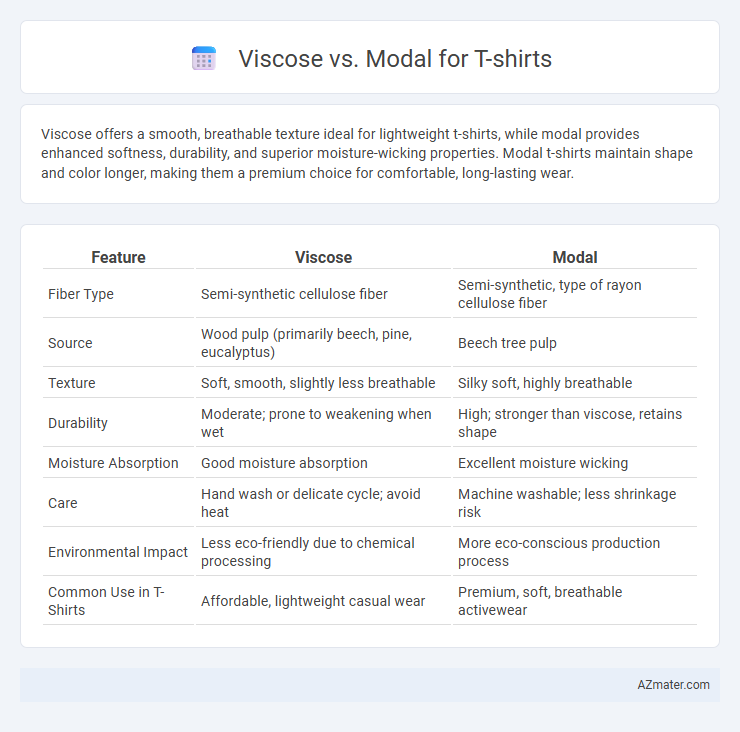Viscose offers a smooth, breathable texture ideal for lightweight t-shirts, while modal provides enhanced softness, durability, and superior moisture-wicking properties. Modal t-shirts maintain shape and color longer, making them a premium choice for comfortable, long-lasting wear.
Table of Comparison
| Feature | Viscose | Modal |
|---|---|---|
| Fiber Type | Semi-synthetic cellulose fiber | Semi-synthetic, type of rayon cellulose fiber |
| Source | Wood pulp (primarily beech, pine, eucalyptus) | Beech tree pulp |
| Texture | Soft, smooth, slightly less breathable | Silky soft, highly breathable |
| Durability | Moderate; prone to weakening when wet | High; stronger than viscose, retains shape |
| Moisture Absorption | Good moisture absorption | Excellent moisture wicking |
| Care | Hand wash or delicate cycle; avoid heat | Machine washable; less shrinkage risk |
| Environmental Impact | Less eco-friendly due to chemical processing | More eco-conscious production process |
| Common Use in T-Shirts | Affordable, lightweight casual wear | Premium, soft, breathable activewear |
Understanding Viscose and Modal Fibers
Viscose and modal fibers both originate from cellulose, primarily derived from wood pulp, but modal undergoes a more refined processing that enhances its strength and softness compared to viscose. Modal fibers exhibit higher moisture absorption and improved durability, making them ideal for T-shirts requiring a smooth touch and longevity. Viscose tends to drape well and offers vibrant color retention, yet it is less resistant to abrasion and shrinkage than modal, influencing fabric performance in everyday wear.
How Viscose and Modal Are Made
Viscose is produced through a chemical process that transforms wood pulp into regenerated cellulose fiber, involving the treatment of cellulose with sodium hydroxide and carbon disulfide to create viscose solution, which is then spun into fibers. Modal is a type of high-wet-modulus rayon made from beech tree pulp and undergoes a similar but more refined chemical process that includes extra washing and stretching steps, resulting in a stronger, more durable fiber compared to traditional viscose. Both viscose and modal manufacturing processes rely on sustainable raw materials but differ in fiber treatment, affecting the final T-shirt's softness, strength, and moisture-wicking properties.
Comfort and Feel: Viscose vs Modal
Modal fabric offers superior softness and a smoother feel compared to viscose, making it ideal for T-shirts that prioritize comfort. Viscose provides a lightweight and breathable texture but can lack the silky smoothness and durability found in modal. Both fabrics are moisture-wicking, but modal's enhanced fabric resilience contributes to maintaining comfort and softness over multiple washes.
Durability and Longevity Comparison
Modal fabric offers superior durability compared to viscose, maintaining its strength and shape after multiple washes, making it ideal for long-lasting T-shirts. Viscose, while soft and breathable, tends to weaken and pill more quickly, reducing the garment's overall lifespan. Modal's enhanced resistance to shrinkage and fading ensures T-shirts retain their appearance and fit over prolonged use.
Moisture Wicking and Breathability
Modal fabric offers superior moisture-wicking capabilities compared to viscose, efficiently drawing sweat away from the skin to keep the wearer dry during physical activities. Both viscose and modal provide excellent breathability due to their natural fiber origins, but modal's finer weave enhances airflow, preventing overheating. Modal's high moisture absorption combined with quick drying properties makes it a preferred choice for breathable, moisture-wicking T-shirts.
Eco-Friendliness and Sustainability
Viscose and Modal are both semi-synthetic fibers derived from cellulose but Modal is considered more eco-friendly due to its production process using beech trees with less water and chemicals compared to viscose, which often involves intensive chemical treatments and deforestation concerns. Modal fibers offer higher durability and biodegradability, making Modal T-shirts more sustainable and longer-lasting in everyday wear. The eco-conscious choice favors Modal for reducing environmental impact and supporting sustainable forestry practices in apparel manufacturing.
Dye Affinity and Color Retention
Modal fabric exhibits superior dye affinity compared to viscose, allowing it to absorb colors more deeply and uniformly, resulting in richer hues. Viscose T-shirts may experience faster color fading due to weaker dye retention properties, especially after multiple washes. Modal retains vibrant colors longer, making it a preferred choice for T-shirts requiring consistent color quality over time.
Price Differences and Value
Viscose offers an affordable option for T-shirts with a soft texture and good breathability, typically priced lower than modal due to its simpler manufacturing process. Modal, derived from beech tree pulp, commands a higher price because of its enhanced durability, moisture-wicking properties, and resistance to shrinking and pilling. The higher investment in modal T-shirts often translates to better long-term value through extended wear and maintained fabric quality.
Best Uses for Viscose and Modal T-Shirts
Viscose T-shirts excel in breathability and moisture absorption, making them ideal for casual wear and warm climates where comfort and softness are essential. Modal T-shirts offer enhanced durability, increased resistance to shrinking, and a silky texture suited for activewear and garments requiring frequent washes. Both fabrics provide excellent drape and color retention, but Modal outperforms Viscose in stretch recovery and longevity, making it preferable for high-performance or long-lasting casual apparel.
Which Fabric Should You Choose?
Viscose offers a soft, breathable feel ideal for everyday T-shirts, while Modal excels in moisture-wicking and durability, making it suitable for activewear. Choose viscose for lightweight comfort and a silky texture, but opt for Modal if you prioritize enhanced strength and resistance to shrinkage. Both fabrics provide excellent drape and comfort, with Modal generally being more eco-friendly due to its sustainable production process.

Infographic: Viscose vs Modal for T-shirt
 azmater.com
azmater.com